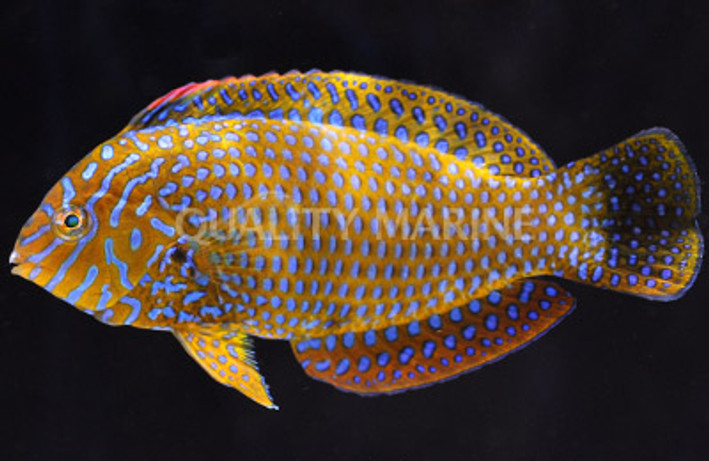Geoffroyi Wrasse
(Macropharyngodon geoffroyi)
Macropharyngodon Wrasse are also known as Leopard Wrasses. They should be added to well established aquariums with plenty of room to swim. Plenty of rock work should be provided for hunting and hiding. Leopard Wrasse are very active during the day looking for small invertebrates, crustaceans and snails. A deep sand bed is also needed for burrowing at night or when threatened. A diet of rich in meaty based foods should be provided, if Wrasse ignores preparations live foods such as small shrimp may need to be supplemented. Leopard Wrasse are hermaphroditic meaning females may at some point in their life may turn into a male. Leopard Wrasse can be difficult to house we recommend expert hobbyists only. Leopard Wrasse tend to be shy and easily harrassed but do thrive in a harem of 1 male and several females if added at the same time. Leopard Wrasse may be sensitive to copper be sure to monitor aquarium levels. Leopard Wrasse also see marked male and female color differences. Wrasse may jump be sure to provide an aquarium with a tight fitting lid.
The Geoffroyi Wrasse are sometimes also known simply as the Potters Leopard Wrasse. Occasionally seen in the aquarium trade. Female and male Blue Spotted Leopard Wrasse may have color variations depending on maturity, collection areas and breeding periods. Females are a yellow to orange color with dark trimmed blue spots while males are a red to orange color with dark edged blue spots. Geoffroyi Wrasse can grow to a little over 6".
We recommend a minimum aquarium size of 75 gallons or larger for this species.
Water conditions: Salinity 1.020 - 1.025, Temp (F) 72 - 78, pH 8.1 - 8.4, Alkalinity 8 - 12 dKH
-
Care:
 Moderate
Moderate
 Difficult
Difficult
-
Behavior:
 Social
Social
-
Diet:
 Frozen Food
Frozen Food
 Live Food
Live Food
-
Habitat:
 Reef
Reef
 Sand Flat
Sand Flat
-
Light:
 Medium
Medium


 Moderate
Moderate
 Difficult
Difficult
 Social
Social
 Frozen Food
Frozen Food
 Live Food
Live Food
 Reef
Reef
 Sand Flat
Sand Flat
 Medium
Medium